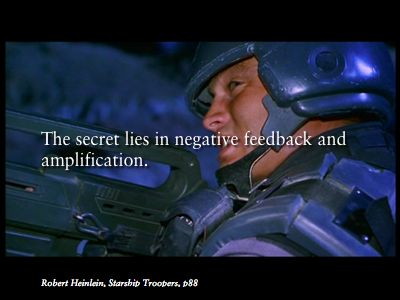
Before we do, just a sidetrack into Robert Heinlein and Starship Troopers. It’s a film of dubious politics, though the book explains them better. The conceit is the concept of the Mobile Infantry, and their powered suit. In a future world of planet-blasting bombs and space travel, why do we need soldiers – the M.I. – in what is essentially computerised armour?
Heinlein explains:
“We make war as personal as a punch in the nose.”
There’s a pride in the job, even though it’s the dirty work: “All the others are button pushers or professors, along merely to hand us the saw; we do the work.”
The suit does everything for the M.I.: Jets for a three-jet shove jump, three audio circuits, goggles to see in infra-red.
“You want circuit A to your squad leader, you bite down once—for circuit B, bite down twice—and so on. The mike is taped to your throat, the plugs are in your ears and can’t be jarred out; just talk.” It has binaural hearing, or suppression of noisy neighbours.
It’s all operated with nods, bites and movements that can be used from the first time you wear the suit, and gives you superpowers.
How does Heinlein make this a believable artefact? By invoking cybernetics: “The secret lies in negative feedback and amplification.”